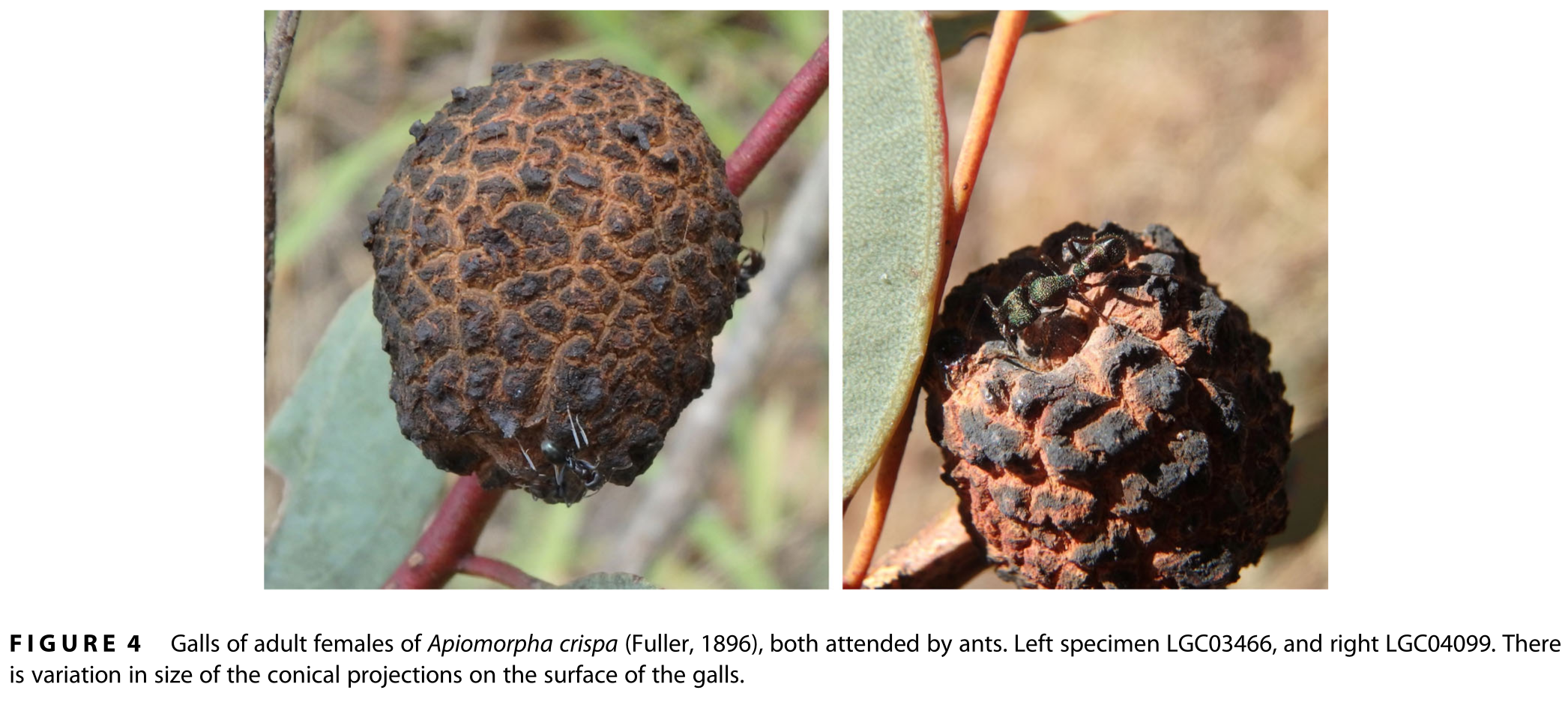Valid Names Results
Apiomorpha crispa (Fuller, 1896) (Eriococcidae: Apiomorpha)Nomenclatural History
- Brachyscelis crispa Froggatt 1894a: 76. nomen nudum (discovered by Gullan1984, 58).
- Brachyscelis crispa Fuller 1896: 697. Type data: AUSTRALIA: New South Wales, Booral. , female, accepted valid name Notes: It is possible that specimens in the collection at ASCT are part of the type series (Gullan 1984). She considered that galls labelled “No. 1706E/Gall making coccids/Brachyscelis crispa, Olff./Male and female galls of Eucalyptus./N.S.W.” may belong to Fuller’s original material’. They are currently housed at the ASCU, Orange Agricultural Institute, New South Wales, Australia. (Fan, et al., 2025) Illustr.
- Apiomorpha strombylosa; Froggatt 1898a: 58. incorrect synonymy Notes: Incorrect citataion of Olliff MS as author
Common Names
Ecological Associates
Hosts:
Families: 1 | Genera: 1
- Myrtaceae
- Eucalyptus crebra | FanCoDa2025 Gullan1984 LeBretVa1993
- Eucalyptus granitica | FanCoDa2025
- Eucalyptus leptophleba | FanCoDa2025
- Eucalyptus polyanthemos | FanCoDa2025 Gullan1984
- Eucalyptus siderophloia | FanCoDa2025 Gullan1984
Geographic Distribution
Countries: 1
- Australia
- New South Wales | FanCoDa2025 Gullan1984 LeBretVa1993
- Queensland | FanCoDa2025 Gullan1984
- Victoria | FanCoDa2025 Gullan1984
Keys
Remarks
- Systematics: Adult females of Apiomorpha crispa differ from those of A. strombylosa in having fimbriate to subfrimbriate trilabiate spiracles rather than typical trilabiate spiracles, and in having fewer spine-like setae on TII–AI (≤2 on TII, ≤7 on TII, ≤6 on AI). It also differs by inducing galls on E. Sect. AdnatariaLatoangulatae and E. Sect. Maidenaria but never on the same host Sections as A. strombylosa (E. Sect. Bisectae and E. Sect.Glandulosae).
- Structure: Mature gall subspheroidal, 15–25 mm long, 10–22 mm wide, sessile, attached either basally or obliquely to stem, with broad attachment. Apex often distinctly truncate, sometimes depressed, with a central cone; apical orifice usually circular, surmounted on central cone. Gall cavity ovate with apical end acuminate; internal surface covered with white, powdery wax which is also conspicuous at orifice of galls with live female; gall wall thick. Living gall reddish brown to black; surface rough, covered with small, irregular protuberances; resembling a seed cone of some she-oak (Casuarinaceae). Galls of females of A. crispa are typically induced on stems and occur either singly or in clusters. Galls of males are induced on leaves, petioles and stems, commonly very densely
- General Remarks: Original description by Fuller. Detailed redescription, and photos of galls in Fan, et al., 2025.
Illustrations
Citations
- CookGuSt2000: nymph, 882-883
- FanCoDa2025: description, distribution, genetics, host, morphology, taxonomy, 1-10
- Frogga1898a: description, taxonomy, 11-12
- Fuller1896: description, distribution, host, illustration, taxonomy, 209-218
- Fuller1899: taxonomy,
- Gullan1984: description, distribution, taxonomy, 58-62
- Houard1923: description, illustration, taxonomy, 621, 622



